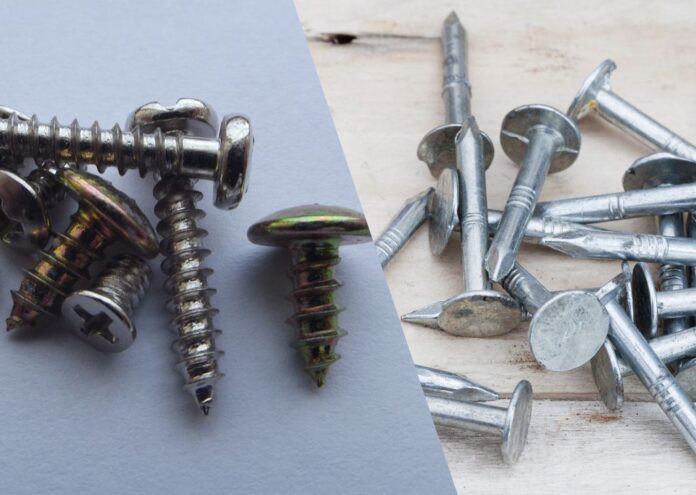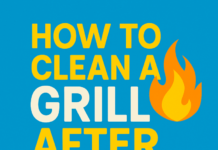“When to use screws vs nails” is a question we have seen pop-up again and again in our Tools in Action forum. Lucky for you, I am sharing my knowledge as a hobby woodworker of the past 30+ years to clarify when to use a screw or a nail in a woodworking or carpentry project. We will go over some key differences between the two, a fun experiment you can do at home, and a simple overview of which fastener is best for a variety of different builds and projects.
Difference Between Nails and Screws
Nails and screws are both fasteners, which are small materials designed to hold other materials together, such as: wood, plastic, drywall, cement, metal, and so on. However, screws and nails are designed to hold these materials together differently. The key and obvious difference between a nail and a screw is that a screw has threads on the shaft that spiral down from top to bottom (or entry point), and nails are smooth with a tipped point at the end (again, or entry point). And despite being similar in shape and function each requires different tools for fastening.
Screws with their spiral threads require some type of screwdriver, whether this is a manual screwdriver, or electric screwdriver or drill. This tool drives the screw into the materials you are fastening together.
Nails are smooth and can be fastened with a hammer. Nails are designed with a flathead on top to prevent the nails from sinking into whatever material you are driving the nails into. A standard hammer is a go-to tool for a lot of nailing applications. However, nails can also be driven into materials with power tools, such as an electric or pneumatic nail gun.
Now that we’ve outlined the key visual differences between screws and nails we can jump into when to use nails vs screws and vice versa.
When to Use Screws vs Nails
Now the big questions: “When do I use a screw? And when do I use a nail?”
The answer to this common question almost always comes down to the kind of movement the material you are fastening naturally experiences and how to stop it. These two movements are side-to-side and up-and-down.
When to use a nail
It’s a good rule of thumb to use a nail whenever there is sideways movement, or “lateral force”, in the material that you are joining. This means that the material is going to move left or right. A nail is better than a screw for this because the smooth surface of a nail holds shear weight better than a screw.
A few examples of projects with lateral force, or when to use nails, include…
- Framing or structural projects
- Deck joists
- Fastening shelf supports to a stud
Nails are also a great option for projects that benefit from or require some flexibility.
I know. We generally associate fastening with a strong hold. However, certain materials expand and contract due to forces like weather or temperature, and a nail can be the best fastener for these applications. For instance, when installing vinyl siding or asphalt shingles.
Exception: Despite having lateral force, drywall screws are the go-to for installing drywall. Nails will ease their way out of drywall over time and create “drywall pops“.
Each nailing project benefits from a specific kind of nail. We won’t go into that today but stay tuned for our Tools in Action article: Different Types of Nails and When to Use Them.
When to use a screw
You have probably guessed that if you use nails when material move left or right, that means you use screws for fastening materials with up-and-down movement, aka medial force. This is because the threads on a screw hold material together better over time, whereas nails will gradually rise up and out. This makes nails ideal for structural or framing applications.
A few examples of projects with medial force, or when to use screws, include…
- Fastening planks to a deck or subfloor to floor joists.
- Fastening a shelf to drywall
As you see, screws are an ideal fastener for medial force with the exception of drywall screws.
Projects that require screws benefit from using the specific types of screw for that unique application. We won’t go into that today, but stay tuned for our Tools in Action article: Different Types of Screws and When to Use Them.
Test it Out: Screws vs Nails
If you are still confused by when to use screws vs nails then it might help to see these fasteners in action. This an easy experiment you can do at home with just a few items.
For this experiment, you will need…
- Two nails
- Two screws
- Hammer
- Electric screwdriver or drill
- A block of wood (your local hardware store may have scrap wood you can use for this)
Once you have these items this whole experiment can be completed in three easy steps:
Step 1: Drive the screws and nails only halfway into the wood. Provide at least an inch of space between each one. It’s up to you what order you fasten the screws and nails to the wood in (ex: screw, screw, nail, nail, vs screw, nail, screw, nail, and so on).
Step 2: Use the claw side of the hammer to pull up on one nail and one screw. SPOILER: the nail is going to come out a lot easier than the screw, which may still be stuck in the wood.
Step 3: Make sure the block of wood is turned so that the remaining nail and screw are pointing out to the side, preferably poking out over the edge of a surface. Use your hammer and strike down on the nail and screw. SPOILER: the nail bends, but stays in place. However, the screw has either broken or there is no longer securely in the wood, which could also be fairly damaged.
I hope this little experiment helps you understand why it’s best to use screws for materials with up-and-down movement, and nails when materials have side-to-side movement.
Other Types of Fasteners
Nails and screws are not the only types of fasteners for woodworking and carpentry projects. There is glue, hook and loop, staples, dowels, nuts, bolts, washers, and more. We’ll dive more into these on a different day.
If you’re interested in learning about the different types of fasters, then stay tuned for our Tools in Action article: Other Types of Fasteners for Woodworking and Carpentry Projects.
Let us know about other types of common building questions you have in the comments and we will work to bring you the answers.





Great article and tips. Never really knew this before.
Very informative, I prefer screwing to nailing! HA
That was funny
lol
I’m new to wood work this was very informative. 29
Thanks for the feedback. I love woodworking and sure you will also. Pretty cool to be able to build something from nothing.
Great to know thanks for the tips Eric!!